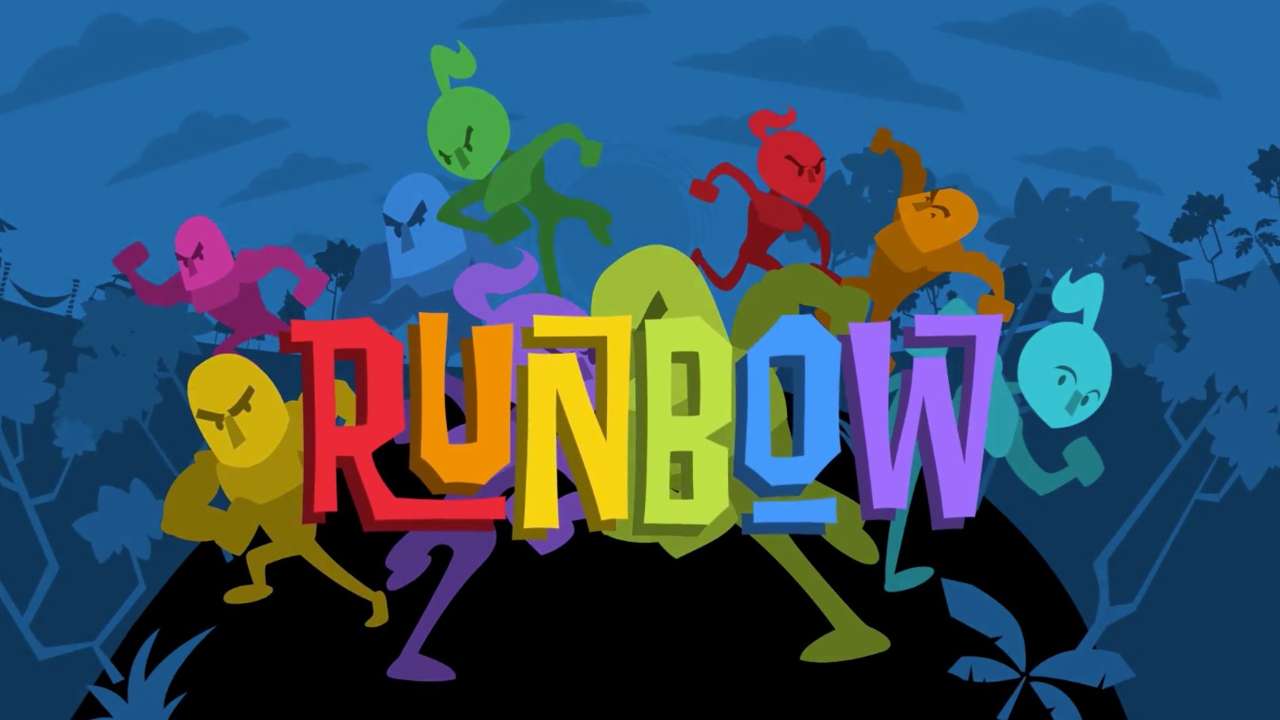Runbow is one of the most highly publicized Wii U-exclusive indie games set to release in 2015. The debut project of upstart Toronto-based developer, 13AM Games, Runbow is a staggering nine-player (yes, nine!) combo of fast-paced platformer and racing game.
I must confess that I wasn’t quite sure what to make of Runbow in just about every instance that I heard about it from Wii U eShop channels. It’s one of those games that you just need to try for yourself to understand. Fortunately, once you do, the appeal of Runbow is immediately very evident!

The game’s E3 demo offered two means of gameplay. The first simply allowed you to play a montage of courses, which the demo restricted to five rounds. This is obviously where the multiplayer focus is meant to come into play, with (ideally) a group of nine players all scrambling as vibrant cartoon people that take on the various colours of the rainbow. It appears that each colour has both a male and female option as well, and I sampled both ‘red’ variations during my time with the demo. Beyond their colouring, all of the characters seem to be identical. This is also apparently true of hidden ‘guest characters’ from other indie games, such as Guacamelee!’s Juan Aguacate, Bit.Trip’s Commander Video, and the title character of Shovel Knight, all of whom, among others, can be unlocked in the final game.
Despite having to play it solo, the round-based running mode allowed me to get a handle on how the game is played, and it’s incredibly creative! The demo allowed me to sample virtually every potential control option, minus Wii Remote/Nunchuk, which is supposed to allow one player to use the Nunchuk, while another uses the Wii Remote. It’s kind of an unheard-of loophole in modern Nintendo controller design, with the game able to achieve a nine-player count by having two players on each Wii Remote/Nunchuk or Wii Remote/Wii Classic Controller variation, with the remaining player using the Wii U Gamepad, something that offers off-TV play as well, with the Wii U Gamepad Screen perfectly mirroring the action on the television as I played. A Wii U Pro Controller option is also offered, and that’s the one I used the most in the demo, even if part of me best enjoyed playing with a sideways Wii Remote, given Runbow’s simple and accessible control scheme.
As you dash through each area of Runbow, the background colour palette changes every few seconds. You’ll also notice that the various platforms, along with some walls, are given multiple variations of colour, with regular ground and structuring simply being in persistent black. This means that, whenever the background palette matches the colour of walls or platforms, those walls and platforms will disappear for a second. This, paired with some very smart and inspired level design, makes Runbow a very exciting and enormously imaginative experience, even if you’re playing by yourself! When playing with others however, it does make for the opportunity to continually change up the gameplay with some pretty unpredictable multiplayer hijinx, as players stepping all over each other in a frantic rush to get to the goal could result in them getting platforms disappearing, or walls stopping them cold, right as they appear to be pulling ahead. It’s a very funny, and clever idea!

For solo players, the Challenge Mode that the demo also offered will probably be a more frequent stop. A handful of stages were included, among them being a treacherous waterfall climb, and a devious arrangement of walls and spikes. Each level had a cheeky name, and if you die, you’ll be restarted at the area entrance, after a suprisingly huge list of potential, facetious jabs that the game takes at your expense. Likewise, if you win, the game gives you a different victory line every time. There’s tons of detail put into the colourful, tongue-in-cheek presentation of Runbow, which boasts an enormous amount of style, and brings together its visuals and gameplay hook incredibly well!
I scored anywhere from one to three medals in the sample Challenges, with Runbow said to be featuring both score-chasing incentives and in-game achievements in its final version. The game seems like a fantastic way to hone your platforming skills, and can be remarkably challenging as well, albeit not in an unfair way. Most importantly is that this E3 demo showed me that Runbow is excellently designed. It’s small wonder that this is one of the Wii U’s most publicized indie games this year, since Nintendo certainly snared a fantastic indie experience for themselves in Runbow!

I felt a bit disappointed that I couldn’t experience the manic, often hilarious action of Runbow with a full squad of nine players, where the game is no doubt at its best. Still, I had a lot of fun taking on the Challenge Mode, and even the basic running mode carries with it a ton of promise. I certainly died quite a lot during my demo playthrough, but where many games would annoy me or perhaps elicit no reaction as I simply concentrated further, Runbow had me chuckling with each defeat. There’s something strangely hysterical about how the entire game presents itself, and even as the level design inevitably vexes you, you can’t help but smile at the whole thing.
I find it a bit difficult to adequately sum up exactly what makes Runbow so special, but believe me, you just have to try it. The way its working parts come together is so remarkable, and after I finally got hands-on time with it, Runbow has shot up to being one of my most anticipated indie games on any platform this year, let alone Wii U! Whether by yourself, or with a group of friends, I imagine that this will be one of the Wii U’s best games this year!
It will certainly be the most colourful, at least!

